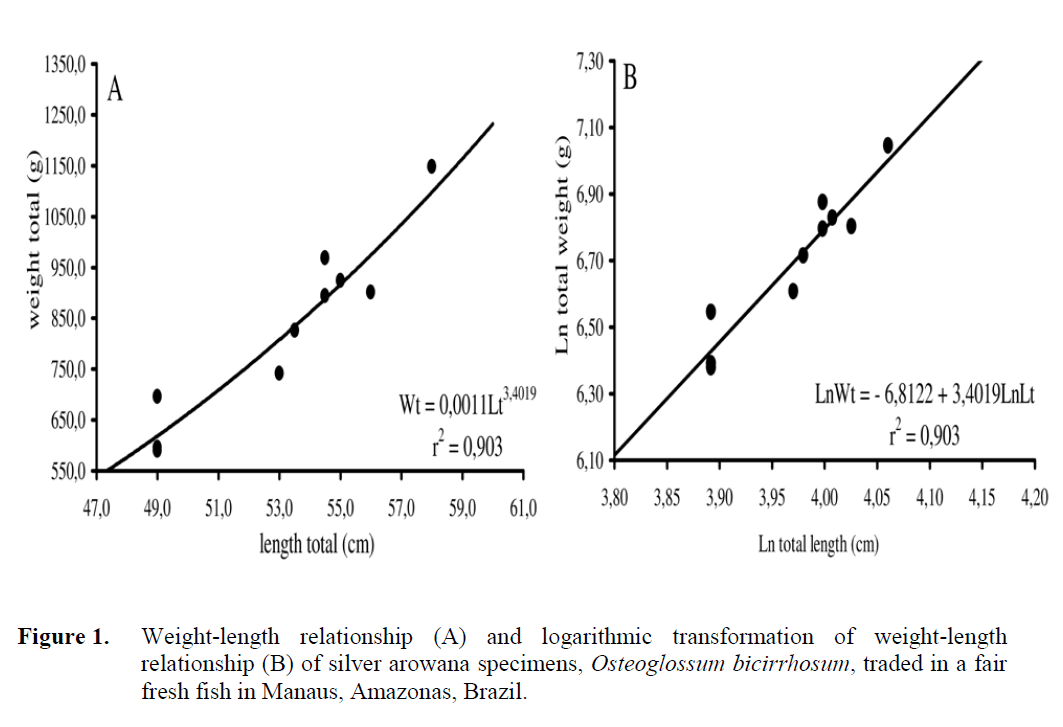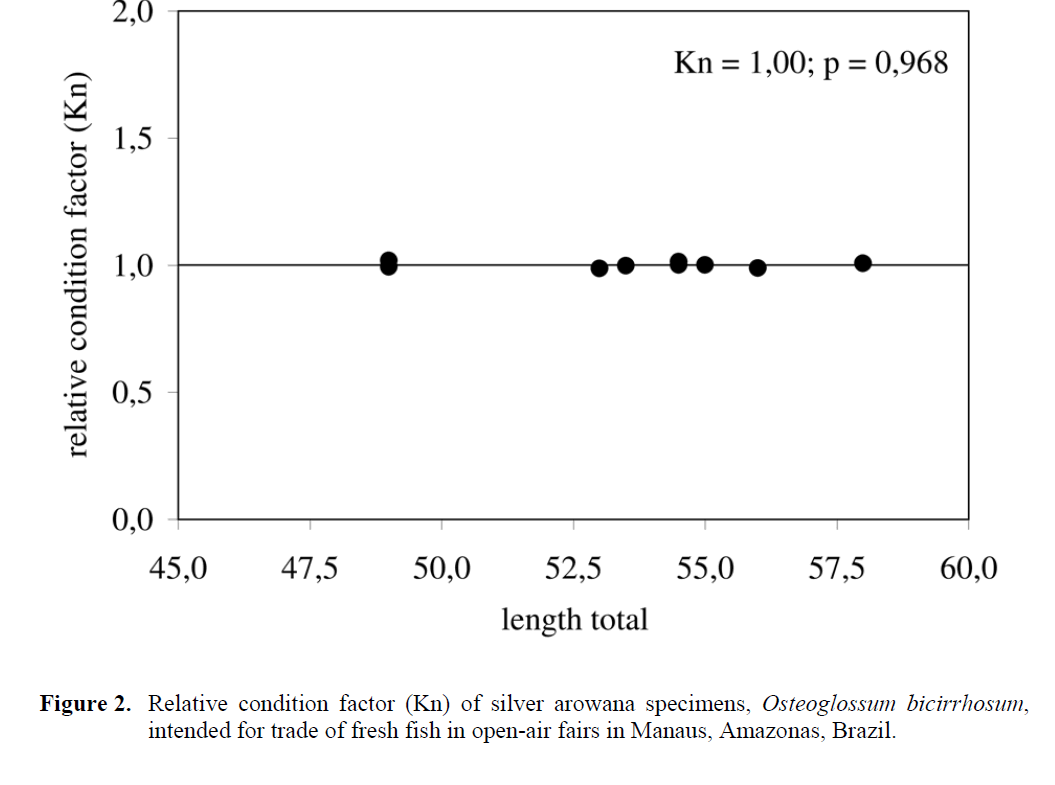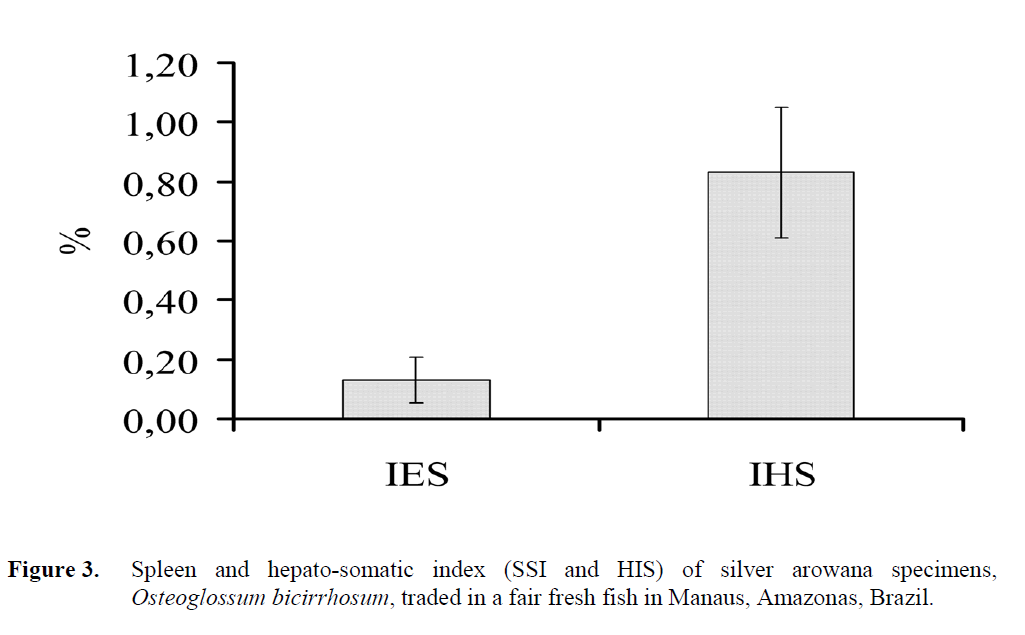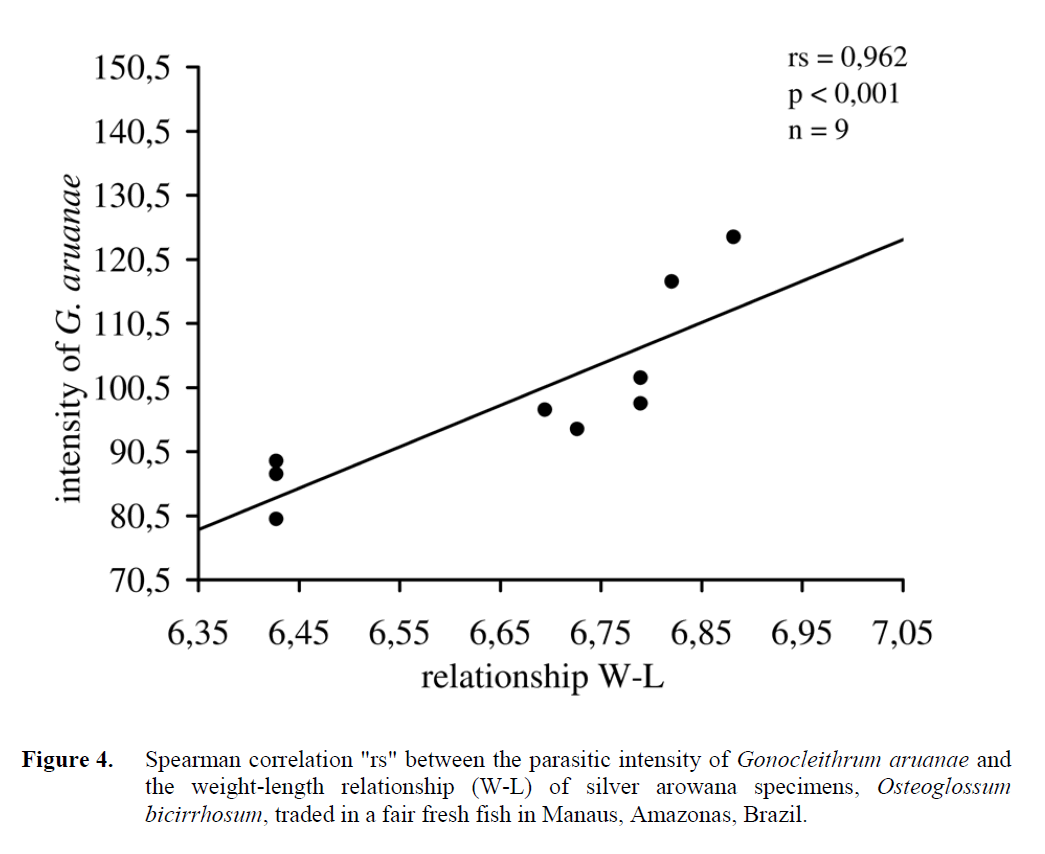Key words
Arowana, Condition Factor, Somatic Index, Parasites of Fish, Health
Introduction
The silver arowana, Osteoglossum bicirrho-sum, family Osteoglossidae, is a fish with a com-pressed body that can reach a total length of 1 m and more than 2.5 Kg. It has bony and rough tongue, barbels at the tip of the chin and large scales with silver coloration. This fish lives in lakes of flooded forests of the Amazonas river basin, being found near aquatic vegetation where it feeds primarily on insects and spiders that fall into the water or that are in stems, branches and lianas, due to the ability to jump out of the water (Lowry et al., 2005). In the Amazonas State, this fish is important for the ornamental fish industry and fish market for food consumption, available in several fish trade fairs.
The commercialization of fish intended for consumption may be affected by several prob-lems related to sanitation, among which stands out parasitic diseases which can represent risk of zoonosis to human, affect the appearance of fish (Ubeira et al., 2000) or interfere with growth rate (Lizama et al., 2007). Thus, the periodic parasite assessment of fish is very important because some diseases are associated to food intake and often the fish responsible for the disease is not available to analysis, making difficult to identify the true etiologic agent (Imam and Dewu 2010).
The health status of fish can also be evaluated through the determination of the condition factor, as this specifies the ideal body condition in a certain size range, and can be affected by para-sitism, nutritional status, mobilization of energy reserves and other biotic and abiotic factors which can influence fish health (Tavares-Dias et al., 2000a; Lemos et al., 2006; Lizama et al., 2007; Gomiero et al., 2008; Tavares-Dias et al., 2010), are also used to evaluate fish healthiness, the somatic index of spleen (spleen-somatic ín-dex) and liver (hepato-somatic index), because these are linfomielopoietic organs which may be changed due to agents that stimulate the produc-tion and differentiation of erythrocytes and leu-kocytes, or the use of energy reserves (Laidley et al., 1988; Tavares-Dias et al., 2000a,b; Wilkie 2002).
Despite the great importance of fish con-sumption by Amazonian populations and sanitary quality of the commercialized fish, little is known about the fish sold in the markets of the region. The present study is the first objectifying to eval-uate the parasitic fauna and body index of O. bi-cirrhosum. The results obtained in this study has practical application and provide subsides for the fish traded in the Amazonas State.
Material and Methods
Fish were collected at the region of Castanho Lake, Amazonas Basin, Amazonas State, by pro-fessional fishermen using a gillnet. Approxi-mately three hours after being removed from the nets, fish were placed on ice and transported to a market of fresh fish at Porto da Ceasa, Manaus, Amazonas. Immediately upon arrival at the mar-ket, before commercialization, 10 specimens of O. bicirrhosum (9 females and 1 male) were sampled and transported to the Laboratory of ap-plied Zoology, Nilton Lins University, to perform biometrics analysis, dissection, determination of somatic index and parasitological examinations.
Total mass, total length and standard length were determined. The data on mass and length were used for the determination of the weight-length relationship (W-L) trough the logarithmic formula LnWt = Ln a + LnLt. The relative con-dition factor (Kn) was evaluated separately for each experimental group using the formula Kn = Wt/aLtb (Le Cren 1951). The type of growth was evaluated by the value of the angular coefficient of the weight-length relationship (b) (Oscoz et al., 2005). Subsequently, nostrils, eyes, gills, stomach, intestine, kidney, spleen and liver were removed for parasite examination and determination of somatic index. Spleen and liver were weighed on an analytical balance to the determination of spleen-somatic index (SSI) and hepato-somatic index (HSI) using the formula (organ mass x fish weight-1) x 100 (Tavares-Dias et al., 2000b).
An external macroscopic examination of skin and mouth was carried out to identify macropara-sites or lesions caused by them. Next, eyes, nos-trils and stomach were examined visually and also under a stereomicroscope. Gills and intestine were fixed in 5% buffered formalin for later examination. Spleen, liver and kidneys were ma-cerated to allow the examination between slide and cover slip in a microscope. Collection, fixa-tion and quantification of parasites followed the recommendations of Eiras et al. (2006) and Thatcher (2006). Identification was based on the works of Kritsky et al. (1996) and Thatcher (2006). Recommendations of Bush et al. (1997) were followed for parasitic index and ecological terminology.
In order to compare the Kn to 1.00 we apply the Student's t-test, and to correlate parasite in-tensity with biometric variables and Kn the Spearman “rs” correlation was applied. Only the parasites with prevalence greater than 10% were considered (Zar 1999). The level of statistical significance was p ≤ 0.05.
Results and Discussion
Biometric data of the specimens of O. bicir-rhosum studied are presented in Table 1. The in-tercept of the W-L relationship indicates positive allometry (b > 3.00) for this type of growth (Figure 1), in other words, the longer the heavier. This relationship can be used to estimate the weight or the length of the fish when only one of these values is known, providing important data on the fish biomass and allowing the determination of the type of growth, if isometric or allometric (Lemos et al., 2006). This information is unpublished for O. bicirrhosum but it is well known to another widely consumed osteoglosside, Arapaima gigas, for which are related with the types of growth, isometric (Tavares-Dias et al., 2010), positive allometric (Scorvo-Filho et al., 2004) and negative allometric (Ruffino and Isaac, 1995). The W-L relationship can also be used to assess fish healthiness when Kn is determined from it, because it reflects the nutritional status of the fish (Ruffino and Isaac, 1995; Scorvo-Filho et al., 2004, Tavares-Dias et al., 2010) or disease cau-sed by parasite, as observed for Brycon amazoni-cus where Kn was lower in infected fish (Lemos et al., 2007). In aruanã the Kn was not different from 1.00 (p = 0.968), indicating good body con-dition (Figure 2).

Table 1: Relative condition factor (Kn) of silver arowana specimens, Osteoglossum bicirrhosum, intended for trade of fresh fish in open-air fairs in Manaus, Amazonas, Brazil.

Figure 1: Weight-length relationship (A) and logarithmic transformation of weight-length relationship (B) of silver arowana specimens, Osteoglossum bicirrhosum, traded in a fair fresh fish in Manaus, Amazonas, Brazil.

Figure 2: Relative condition factor (Kn) of silver arowana specimens, Osteoglossum bicirrhosum, intended for trade of fresh fish in open-air fairs in Manaus, Amazonas, Brazil.
The values of SSI and HSI of O. bicirrhosum ranged from 0.08 to 0.34% and 0.38 to 1.16%, respectively (Figure 3). The somatic index of the linfomielopoietic organs are very important to understand several disorders that can occur at the environmental conditions that affect the propor-tion of the organ mass in relation to fish mass (Tavares-Dias et al., 2000b; Tavares-Dias et al., 2008). Due to the absence of bone marrow fish use, in addition to kidneys, the spleen as an im-portant erythropoietic organ that provide blood-filtering, and the liver as the organ that produces leukocytary response to infections and stock of energy reserves (Ardell and Woo 2006). The SSI and HSI can be used to demonstrate differences among species, as shown to B. amazonicus and Colossomoma macropomum (Tavares-Dias et al., 2008) and in the comparison of Oreochromis ni-loticus and Piaractus mesopotamicus, Leporinus macrocephalus and the hybrid tambacu, or to correlate to the levels of parasitic infestation, as demonstrated for O. niloticus (Lizama et al., 2007) and P. mesopotamicus (Tavares-Dias et al., 2000a). Data of SSI and HSI for O. bicirrhosum generate information for management plans and evaluation of health conditions for the species.

Figure 3: Spleen and hepato-somatic index (SSI and HIS) of silver arowana specimens, Osteoglossum bicirrhosum, traded in a fair fresh fish in Manaus, Amazonas, Brazil.

Figure 4: Spearman correlation "rs" between the parasitic intensity of Gonocleithrum aruanae and the weight-length relationship (W-L) of silver arowana specimens, Osteoglossum bicirrhosum, traded in a fair fresh fish in Manaus, Amazonas, Brazil.
Parasites were diagnosed only in nostrils and gills. In nostrils two specimens of Telethecium nasalis were found Kritsky, Van Every and Boe-ger, 1996 (Monogenoidea, Dactylogyrid), with prevalence in 10% of the fish examined. In gills Gonocleithrum aruanae were found Kritsky and Thatcher, 1983 (Monogenoidea, Dactylogyrid) with 100% prevalence and mean intensity 92.00 ± 24.93 (32-124), and a specimen of Argulus sp. (Branchiura, Argulidae) was observed a positive and significant correlation between G. aruanae and the W-L relationship (Fig. 4). The Specimens of O. bicirrhosum studied were free of endopara-sites with zoonotic relevance.
The two species of Monogenoidea identified are specific to O. bicirrhosum (Kritsky et al., 1996; Thatcher 2006), but this is the first report of the occurrence of Argulus sp. in this fish. These ectoparasites can cause lesions and affect the growth of the hosts when present at high in-tensity of infection, but the Kn values showed that the specimens of O. bicirrhosum presented good body condition. The positive and significant correlation observed between G. aruanae and the W-L relationship, indicate that greater the fish more higher is the infestation by that parasite,
The Monogenoidea and Brachiura is among the parasites which causes most concern for fish hatcheries but are not among the zoonosis that causes concern to human health (Ubeira et al., 2000), unlike endohelminths cestodes, tremato-des and specially nematodes (Oliveira and Viegas 2004). In the case of nematodes, transmission to humans occurs when raw or undercooked fish is eaten, and larvae can migrate to intestines cau-sing diseases (Luque 2004). Recent studies have focused on the larval forms of anisakid nematode due to the increase of the practice caused by ea-ting raw fish, originated from oriental culture (Audicana et al., 2002). In the present study, the absence of endohelminths is a positive note from the health point of view.
Conclusion
In spite of the good body condition and ab-sence of endoparasites with zoonotic relevance, the need for maintenance of good hygiene practi-ces during fish processing such as freezing at ref-rigerated chambers when storage is necessary, good baking of fish before eating and the regular examinations of the other fish species used for human consumption should be emphasized.
Acknowledgment
The authors thank the Graduate Program in Aquaculture and Laboratory of Applied Zoology, located in University Nilton Lins.
597
References
- Ardelli, B.F, Woo, P.T.K., (2006). Immunocom-petent cells and their mediators in finfish. In: Woo PTK (Ed): Fish Diseases and Disor-ders: Protozoan and Metazoan Infections. CAB International, Oxfordshire, Walling-ford, pp. 702-724
- nAudicana, M.T., Ansotegui, I.J., Corres, L.F., Kennedy, M.W., (2002). Anisakis simplex: dangerous - dead and alive? Trends in Para-sitology, 18: 20-25. doi: 10.1016/S1471-4922(01)02152-3
- nBush, A.O., Lafferty, K.D., Lotz, J.M., Shostak, W., (1997). Parasitology meets ecology on its own terms: Margolis et al. Revisited. Journal of Parasitology, 83: 575-583. doi: 10.2307/3284227
- nEiras, J.C., Takemoto, R.M., Pavanelli, G.C., (2006). Métodos de estudo e técnicaslabor-atoriaisemparasitologia de peixes. EDUEM, Maringá
- nGomiero, L.M., Villares JR, G.A., Naous, F., (2008). Relação peso-comprimento e fator de condição de Cichlakelberi(Perciformes, Cichlidae) introduzidosem um lago artificial no SudesteBrasileiro, ActaScientiarum. Bi-ological Science, 30: 173-178
- nImam, T.S., Dewu, R.A., (2010). Survey of pis-cine ecto- and intestinal parasites of clarias species sold at Galadima Road Fish Market, Kano metropolis, Nigeria, Bioscience Re-search Communications, 22: 209-214
- nKritsky, D.C., Van Every, L.R., Boeger, W.A., (1996). NeotropicalMonogenoidea. 27. Two new species of Teletheciumgen. n. from the nasal cavities of Central Amazonian fishes and a redescription of Kritskyiamoraveci Kohn, 1990 (Dactylogyridae, Ancyrocepha-linae), Journal of the Helminthological So-ciety of Washington, 63: 35-41
- nLaidley, C.W., Woo, P.T.K., Leatherland, J.F., (1988). The stress-response of rainbow trout to experimental infection with the blood parasite CryptobiasalmositicaKatz, 1951, Journal Fish Biologiy, 32: 253-261. doi: 10.1111/j.1095-8649.1988.tb05359.x
- nLe Cren, E.D., (1951). The length–weight rela-tionship and seasonal cycle in gonad weight and condition in the perch (Percafluviatilis), Journal of Animal Ecology, 20: 201-219. doi: 10.2307/1540
- nLemos, J.R.G., Tavares-Dias, M., Marcon, J.L., Lemos, P.E.M., Affonso, E.G., Zaiden, S.F., (2006). Estudo da relação peso-comprimento e fator de condiçãoemespécies de peixesornamentais do Rio Negro, estado do Ama-zonas, Brasil, IV CongresoIberoamericano Virtual de Acuicultura, 4: 721-727
- nLemos, J.R.G., Tavares-Dias, M., Sales, R.S.A., Nobre-Filho, G.R., Fim, J.D.I., (2007). Para-sitosnasBrânquias de BryconAmazonicus(Characidae, Bryconinae) CultivadosemCanais de Igarapé do Tarumã-Mirim, Estado do Amazonas, Brasil, ActaScientiarum. Bi-ological Science, 29: 217-222
- nLizama, M.A.P., Takemoto, R.M., Ranzani-Paiva, M.J., Ayroza, L.M.S., Pavanelli, G.C., (2007). Relaçãoparasito-hospedeiroempeixes de pisciculturas da região de As-sis, Estado de São Paulo, Brasil. 1. Oreo-chromisniloticus(Linnaeus, 1757), ActaScientiarum. Biological Science, 29: 223-231
- nLowry, D., Wintzer, A.P., Matott, M.P., White-nack, L.B., Huber, D.R., Dean, M., Motta, P.J., (2005). Aerial and aquatic feeding in the silver arawana, Osteoglossumbicirrho-sum, Environmental Biology of Fishes, 73: 453-462. doi: 10.1007/s10641-005-3214-4
- nLuque, J.L., (2004). Parasitologia de peixesmarinhosnaAmérica do Sul: estadoatual e perspectivas. In: Paiva, M.J.T., Takemoto, R.M., Lizama, M.A.P., (Eds): Sanidade de organismosaquáticos, pp. 199-214
- nOliveira, E.R.N., Viegas, E.M.M., (2004). Quali-dadedopescado. In: Ranzani-Paiva, M.J.T., Takemoto, R.M., Lizama, M.A.P., (Eds): Sanidade de organismosaquáticos, pp. 415-426
- nOscoz, J., Campos, F., McEscala, (2005). Weigthlengh relationships of some fish spe-cies of the Iberian Peninsula, Journal of Ap-plied Ichthyology, 21: 73-74. doi: 10.1111/j.1439-0426.2004.00587.x
- nRuffino, M.L., Isaac, V.J., (1995). Life cycle and biological parameters of several Brazilian Amazon fish species, Naga, 18: 41-45
- nScorvo-Filho, J.D., Rojas Net, Silva, C.M., Konoike, T., (2004). Criação de Arapaima gigas(teleosteiosteoglossidae) emestufa e sistemafechado de circulação de água, no Estado de São Paulo, Boletim do Instituto de Pesca, 30: 161-170
- nTavares-Dias, M., Martins, M.L., Moraes, F.R., Kronka, S.N., (2000a). Fator de condição e relaçãohepato e esplenosomáticaempeixesteleósteos de águadocenaturalmentepara-sitados, ActaScientiarum. Biological Sci-ence, 22: 533-537
- nTavares-Dias, M., Martins, M.L., Moraes, F.R., (2000b). Relaçãohepatosomática e esplenosomáticaempeixesteleósteos de cul-tivo intensive, RevistaBrasileira de Zoolo-gia, 17: 273-281
- nTavares-Dias, M., Marcon, J.L., Lemos, J.R.G., Fim, J.D.I., Affonso, E.G., Ono, E.A., (2008). Índices de condição corporal emju-venis de Bryconamazonicus(Spix&Agas-siz, 1829) e Colossomomamacropomum(Cuvier, 1818) naAmazônia, Boletim do In-stituto de Pesca, São Paulo, 34: 197-204
- nTavares-Dias, M., Araujo, C.S.O., Gomes, A.L.S., Andrade, S.M.S., (2010). Relação peso-comprimento e fator de condiçãorela-tivo (Kn) do pirarucuArapaima gigasSchinz, 1822 (Arapaimidae) emcultivo semi-intensivo no estado do Amazonas, Bra-sil, RevistaBrasileira de Zoociências, 12: 59-65
- nThatcher, V.E., (2006). Amazon Fish Parasites. Pensoft Publishers, Sofia-Moscow
- nUbeira, F.M., Valiñas, B., Lorenzo, S., Iglesias, R., Figueiras, A., García-Villaescusa, R., (2000). Anisaquiois y alergia. Um estúdiosoroepidemiológicoem la comunidadAutônomaGallega, Documentostécnicos de SaludPublica, 24: 102
- nWilkie, M.P., (2002). Ammonia excretion and urea handling by fish gills: present under-standing and future research challenges, Journal of Experimental Zoology, 293: 284-301. doi: 10.1002/jez.10123
- nZar, J.H., (1999). Biostatistical analysis. Prentice-Hall Inc., New Jersey












